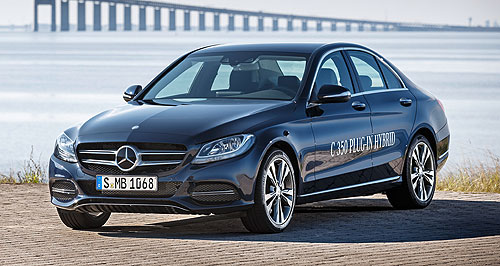Make / Model Search
News - Mercedes-BenzMercedes-Benz backs plug-in hybrids for long termPower points: What once was a stop-gap green technology may become the norm for Merc, as it backs plug-in hybrids for the long term. Change of heart for German powerhouse as fuel cells and EVs take a back seat22 Jul 2015 By TIM ROBSON in SWITZERLAND DAIMLER AG board member and global head of Mercedes-Benz research and development Thomas Weber sees the German car-maker sticking with plug-in hybrids as its preferred green technology for the foreseeable future. Mercedes-Benz currently has two plug-in hybrids in its fleet, but another nine will be rolled out across its fleet by 2017, far outnumbering alternative energy solutions such as pure electric and fuel cell. The new line-up will include the C350h sedan and estate, which will be plugged into the Australian market later this year, while PHEV versions of the GLC, GLE, S-Class, E-Class and ML-Class are also on the cards. Dr Weber told Australian journalists that while pure electric vehicles had their place, cost and convenience had was still the deciding factor for Mercedes and its customers. “We believe plug-in is really important technology, maybe for forever,” he said. “It's an ideal combination of definitely no limitation on the range side, and more and more ability to use zero emission when it's necessary.” Dr Weber also said that while zero-emission small vehicles are ideal solutions for urbanised traffic, it might not be the answer for all vehicles and environments. “Australia why the hell completely zero emission in Australia?” he asked. “In the city, yeah. That's completely the same story around the world. For city cars, compact cars, for the Smart, it's a growing demand for zero emission. But why the hell store whole energy in huge battery packs, which costs thousands of euro?“Therefore, yes we have to go in this direction, technology will help us. Therefore, small cars only battery, probably.” He pointed out that while some brands had successfully put EVs into the spotlight, the overall number of electric cars actually sold was very small. “The number of pure electric vehicles are small, even (with) Tesla in the market,” he noted. “Forget it about the overall number, it's successful, yes, in a niche and a small number. It's not decided yet what (technology) in the end is winning.” The issue of recharging times is not one that can be solved easily, argued Dr Weber, and nor is the argument about who should pay for it. “In the end, yes, this will go to a fast charging station, but it takes nevertheless half an hour at least, because the batteries can't pick up. The remaining biggest opportunities for fuel cells is fast charging time,” he said. With a decade’s experience in fuel cell technology, Dr Weber suggests that hydrogen-derived energy may be best suited to larger applications, but only after suitable infrastructure is constructed. “A Smart with a fuel cell doesn't make sense,” he said. “For the large pure electric vehicle, maybe pure electric with battery or with fuel cell. More is the problem of the infrastructure of power.” Reports suggest that at least half of Mercedes-Benz’s annual three billion Euro research and development budget is dedicated to the reduction of CO2 emissions, and while much of the money will go towards friction reduction, new gearbox technology and further refinement of fuel-burning engines, part of that budget will result in an updated fuel cell system from Mercedes. “We will come with a fuel cell next-generation to the market in some years from now,” Dr Weber confirmed. “It helps technically that now everybody is now going for fuel cell. Maybe in time the game shifts a little bit, but in the end everybody's now going in this direction. It helps that some countries are now doing the next step. “It's not decided, so we have prepare ourselves for this emission-free future.”  |
Click to shareMercedes-Benz articlesResearch Mercedes-Benz Motor industry news |









Facebook Twitter Instagram